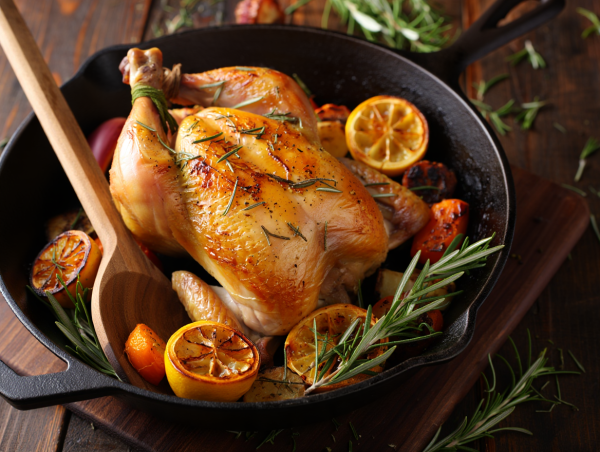
Introduction: The Ritual of Lemon Rosemary Chicken
May 20, 2025
Lemon rosemary chicken: The name is a soft invocation, conjuring sunlit groves and fragrant kitchens. At first glance, it’s a dish that whispers comfort—bright citrus, earthy herb, a promise of crisp skin and tender meat. But the real alchemy happens long before the oven hums to life. It starts in the quiet marinade, where time and patience work their silent magic.
You stand at your counter. The chicken, pale and unremarkable, lies waiting. You zest a lemon, releasing a mist of oils that tingles in your nose. You strip rosemary needles from their stalks, crush garlic, grind pepper, measure salt. Olive oil pools in a bowl, gold and viscous. You combine these elements—simple, yet each with its own volatile edge—and submerge the chicken. There, in the cool embrace of the marinade, transformation begins.
It’s a lesson in restraint. You want to rush, to see, to taste. But you know: the longer you wait, the deeper the flavour. The acids and oils migrate, the rosemary penetrates, the lemon’s brightness lifts the whole. Hours pass. You check, you turn, you wait some more. The anticipation builds—a slow crescendo that rewards not the impulsive, but the patient.
From Kitchen to Market
It’s tempting to see marinating as mere chemistry, a mechanical process. But to marinate well is to understand risk, time, and the uncertain nature of reward. You don’t know exactly how the flavours will settle. You can’t be sure when the chicken is “perfect.” You work with variables: the quality of ingredients, the mood of your oven, and the thickness of the meat. It’s a bet, staked on patience and hope.
This is where the kitchen merges, almost imperceptibly, with the investing world. The act of marinating—of waiting, watching, trusting the unseen—mirrors the deepest rhythms of markets and capital. The marinade is your analysis, your strategy; the chicken, your capital; and time, your most precious resource.
Marinating as Market Wisdom
1. The Power of Patience
Marinating is an act of faith in the future. It’s easy to rush, to cook too soon, to settle for shallow flavour. But the greatest rewards favour those who wait. The acids and herbs need time to permeate, break down, and transform.
Investors, too, are tested by time. The temptation to act—to buy, sell, and react to every market twitch—is ever-present. Yet, as with chicken, the deepest value accrues to those who can wait, who trust their process even when results are not immediate. Like the compounding of returns, the compounding of flavour is slow, almost invisible—until, suddenly, it’s everything.
Ingredients: The Choice of Assets
Not all chickens are equal, just as not all assets are. The quality of your raw material sets a ceiling on your results. Fresh rosemary, vibrant lemons, and good oil are not afterthoughts but the foundation.
In the market, asset selection is paramount. Your chicken and rosemary are the stocks, bonds, or real estate you choose. No amount of patience or skill can redeem a poor foundation. Doing the work upfront—research, due diligence, and selection—magnifies every later effort.
3. The Alchemy of Uncertainty
No two marinades are ever quite the same. The lemon may be sweeter, the rosemary woodier. Even the air in your kitchen has its mood. You adapt, you taste, you adjust. The process is alive, dynamic.
Markets, too, are never static. The variables shift: interest rates, geopolitics, sentiment. Strategies that worked last quarter may need tweaking now. The best investors embrace uncertainty, not as a threat but as the very engine of opportunity. Like chefs, they learn to improvise, to trust their senses as much as their spreadsheets.
Risk Management: The Over-Marinade Trap
Waiting too long can be dangerous. Chicken left too long in acid becomes mush. The very patience that creates depth can, unrestrained, destroy it. Discipline is knowing when to act and move from marinating to cooking.
In investing, risk is ever-present. Time heals many wounds, but not all. There are moments when holding on becomes detrimental—when the market turns or fundamentals erode. Like the chef, the investor must recognise the inflexion point: act too soon, and the gains are green; wait too long, and value rots away.
5. The Reveal: Transformation as Payoff
At last, the chicken meets the heat. The aroma of rosemary and lemon fills the room, a reward for every minute spent waiting. The first bite is revelation—a harmony of flavours that could not exist without time, risk, and restraint.
The investment parallel is the realised gain, the harvest after seasons of preparation and patience. It’s not just about profit; it’s about the satisfaction that comes from seeing a plan through, of understanding that the real magic happens in the waiting, not the doing.
Investor’s Lemon Rosemary Chicken Recipe
A dish of flavour and patience, best served after due diligence and time in the marinade.
Ingredients (Asset Allocation):
- 1 whole chicken or 4 bone-in thighs (quality capital)
- 2 lemons, zested and juiced (citrus = volatility, used wisely)
- 4 garlic cloves, smashed (sharp data points)
- 2 tbsp fresh rosemary, chopped (persistent narrative)
- 1/3 cup olive oil (liquid medium)
- 1 tsp salt, to taste (risk threshold)
- ½ tsp freshly cracked black pepper (market edge)
Optional adds (hedges & derivatives):
- A pinch of chilli flakes (for heat risk-takers)
- A splash of white wine (for optimism)
Instructions (Process Discipline)
- Set Up the Strategy:
Combine lemon zest and juice, garlic, rosemary, olive oil, salt, and pepper in a bowl. Think of this as portfolio construction—everything needs its place and proportion. - Capital Deployment:
Place the chicken in a zip-lock bag or a glass dish. Pour the marinade over. Seal it. Turn to coat. Refrigerate at least 4 hours, ideally overnight. Let time do what time does. - Risk Monitoring:
Turn the chicken once or twice while marinating. Watch for signs of over-acidification. Risk management isn’t hands-off—it’s smartly hands-on. - Market Entry (aka Cooking):
Preheat the oven to 400°F (200°C). Transfer the chicken to a roasting dish. Roast for 35–45 minutes, until golden and the internal temperature hits 165°F (74°C). Patience is cooked into the reward. - Profit-Taking:
Let rest 5–10 minutes before serving. Carve, plate, and garnish with extra lemon zest or rosemary if desired.
Yield: 2–4 servings.
Time to Flavour Maturity: 4–24 hours.
Risk of Ruin: Low, if watched with care.
The Pulse of Process
Mastery is not a single act in the kitchen and the market but a steady pulse of intention, patience, and adaptation. The ritual of marinating and the discipline of investing are twin meditations on what we can control, what we must accept, and when, finally, to act.
Each round teaches us something new: next time, maybe a little more lemon, perhaps a shorter marinade. The process is never finished, only refined.
Conclusion: The Final Loop
So, as you marinate your next lemon rosemary chicken, recognise the decision beneath the surface. You’re not just seasoning meat; you’re practising patience, managing risk, and waging against uncertainty. You are, in miniature, acting out the investor’s recipe—one that rewards those who prepare, wait, and strike with surgical precision.
The kitchen and the market are not so far apart. Both demand patience laced with discipline, intuition sharpened by experience, and the courage to act on conviction. Ultimately, every great meal—and every great investment—is a story of risk transformed by time, and of reward earned by those who dare to wait.
And when you finally lift a fork to your mouth, savour not just the flavour, but the journey. That’s the investor’s dopamine hit: subtle, earned, and intensely satisfying.












